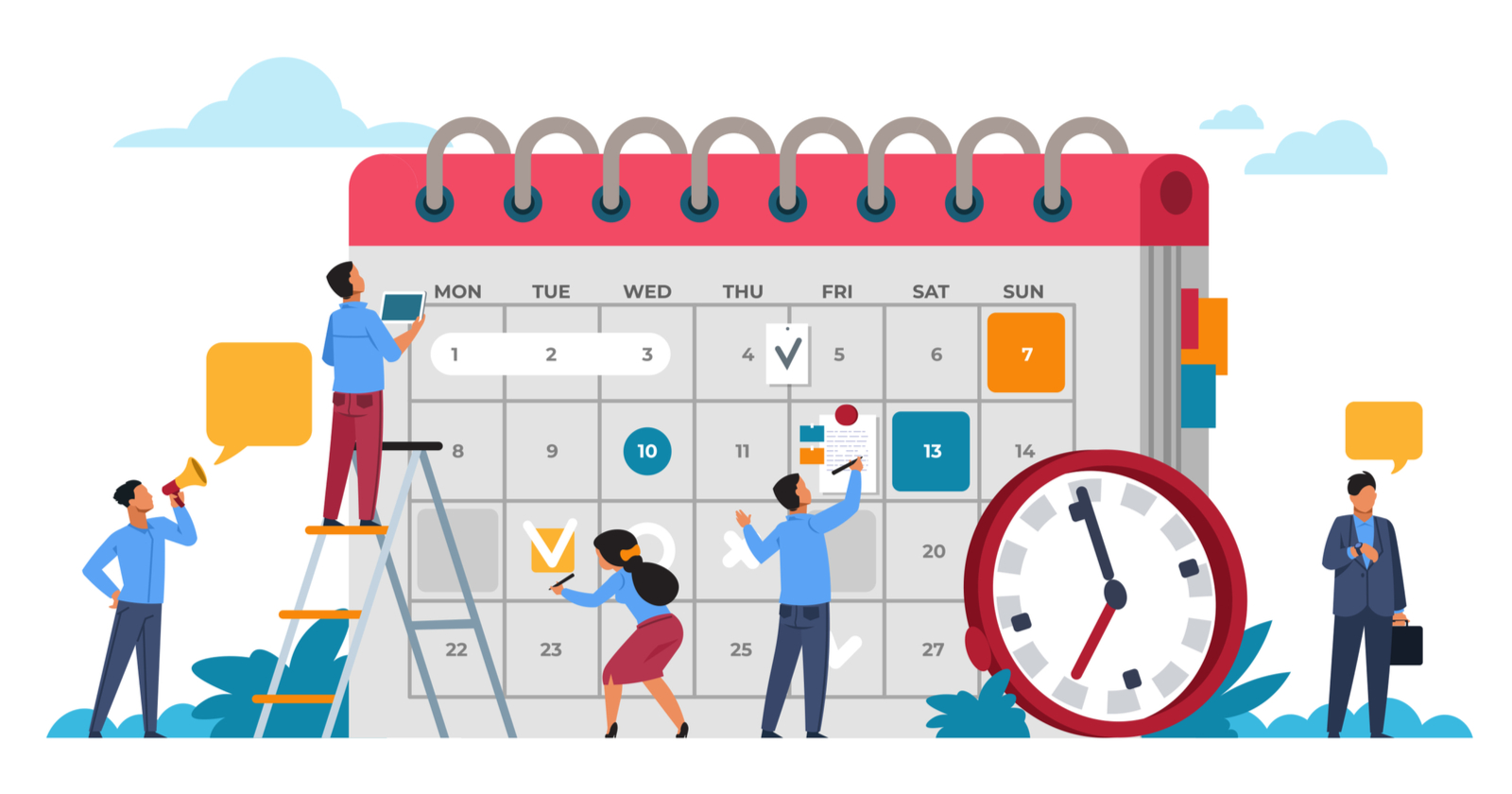A content marketing calendar is a must-have tool if you want to keep your campaigns organized for maximum efficiency, productivity, and performance.
Maintaining an editorial calendar enables you to think more strategically about and better plan the content you will be creating.
We all recognize the importance of taking the time to develop a proper content strategy and not just wingin’ it, right?
Adding data to the mix to inform what goes into the calendar and when will supercharge your efforts and help to ensure long term success.
Calendar Formats
A content calendar can be created in a few different formats depending on the:
- Size of your content team.
- Volume of content you plan to create
- Timeframe you want to plan for.
A Traditional Calendar
Plan out your next week, month, quarter, or even year’s worth of content in a Google calendar or maybe even one of those desktop, papery things.
Simply taking the time to put your planned content into a shared calendar, any calendar, is a great first step.
A Spreadsheet
Use the functions within Google Sheets or Excel to sort and organize your content by date, type, theme, audience, buying stage, etc.
Share this editable document with your team so everyone has visibility into what content is to be created by who and when.
You can even introduce color-coding or other mechanisms to help focus your team’s attention.
A Project/Work Management Platform
When organizations have outgrown spreadsheets and email, which can quickly become bloated and inefficient there are several online task and project management tools like Asana, Monday.com, Trello, Basecamp, or Wrike to streamline processes.
These platforms are designed to help teams manage projects like content campaigns by incorporating calendars, workflows, Gantt or Kanban charts and automated notifications.
A Content Marketing Platform
Content marketing platforms, like CoSchedule, DivvyHQ, Newscred, Percolate, Mintent, and the like are specifically designed to manage content as opposed to general projects.
These tools likewise include custom calendars and other visualizations, configurable content briefs, content filtering, workflows, and notifications.
Many are also integrated with publishing and social distribution platforms to enable management of the full content lifecycle.
Content Planning
Defining Your Audience

Planning what and how to populate your content calendar should always start with clear definitions of member profiles for your target audience.
Take time to create detailed personas of those who will be consuming your content.
Each persona will differ in terms of the way they consume the content you create for them.
These personas should include:
- Demographic information: age, gender, location, marital status, or any other content-related info.
- Preferred content types: text, images, video, audio, print, etc.
- Preferred content channels: social, email, website, offline, etc.
- Consumption behaviors: when (day/time) and how long (short vs. long-form content).
Use these personal details and preferences to guide each piece of content you create and distribute.
Intent-Based Content

So why are you creating all of this content anyway?
The quick and simple reason is to answer all of the questions your target audience has about your products and services in the hope they will engage with you.
But effective modern content marketing goes well beyond describing how your products and services can help your customers.
Organizations and brands are tasked with building trust with their customers by providing a full and optimal experience.
Content must address the full range of intents consumers may have when searching for answers.
Intent or content needs typically fall into one of three categories, which map to a typical buyer’s journey:
- Educational: top of funnel content for those who are just starting to learn.
- Informational: middle of the funnel content for consumers who are comparing solutions.
- Commercial: bottom of the funnel content for those who are ready to proceed/buy.
You can organize and manage your content calendar to make sure you are creating ample relevant content for each of these categories.
Timing

When it comes to social media publishing, in particular, there is a lot of data around when the optimal days and times are to publish content to each of the social networks.
Twitter, Instagram, Facebook, Pinterest, YouTube, etc. have each developed their own algorithms to determine when the most relevant time is to display content to users based on their location, engagement history, and other factors.
There are likewise studies on the best times to deliver email communications to improve open rates and click-throughs.
In addition to studies, you can reference your own social and web analytics to determine your specific audiences’ preferences.
This timing data should be included for each relevant item in your calendar and then cross-referenced once items have been published and distributed.
Content & Resource Management
One of the key benefits of a centralized content calendar is the ability to obtain a bird’s eye view of all or a specific sub-section of the content your team produces over time.
Content managers can quickly review, identify, and address content opportunities or gaps in content topics or types.
Each of the data points captured in your audience personas can be used to more effectively filter and sort the content you create and manage within your calendar; enabling you to better focus your attention and resources as you roll out your campaigns.
An up-to-date calendar will also enable you to effectively manage resources by seeing which of your team members are available to work on specific projects or tasks.
By assigning a priority to each content item, you can ensure projects stay on schedule and budget.
Run regularly scheduled reports to see where there may be bottlenecks in your processes and where efficiencies can be gained.
Using Data to Focus
Topical Keywords

Another way to organize your calendar is by topical keyword group, which is the currently preferred SEO method for establishing authority through content creation.
The importance of topical authority dates back to Google’s release of the Hummingbird algorithm back in 2013.
This algorithm along with the more recent release of BERT, changed the way the search engine analyzes and ranks content.
The focus changed from mere keywords to broader keyword groups and related contextual content.
Many SEO professionals subscribe to a content pillar strategy whereby several complementary pieces of content (e.g., blog posts or articles) are linked to a primary pillar piece all of which incorporate relevant, topically related keywords. Google is able to effectively tie these pieces together and ascribe authority.
Today’s keyword research is all about identifying the keywords for which you have already established some level of authority and momentum (i.e., keywords for which you have ranking content) or the ones you believe you can realistically develop organic visibility for in a reasonable period of time.
Analytics

Content engagement, conversion, and overall performance should naturally be top of mind when effectively managing any content campaign.
Analytics can be used either historically or in real-time to track progress and guide the creation or distribution of content, by enabling you to validate which content types, topics, and/or channels are working and which are not.
Analytics enable data-driven teams to learn from past campaigns or optimize their current campaigns on the fly.
The performance of each piece of content can and should be accessible and reflected within your editorial calendar so you and your team members can quickly visualize the results of your efforts and adjust your campaigns accordingly.
Cheers to Organization
Whether you’re a team of one or 100, a well mapped out, strategy-led content calendar will help guide your thoughts, resources, and campaigns for optimal performance.
You will appreciate being able to see all of your content, logically organized in one central location.
Applying data from relevant sources and adjusting content where necessary to ensure you are addressing the needs of your target audience, will drive your results to the next level.
More Resources:





